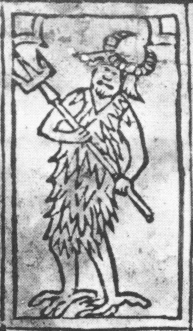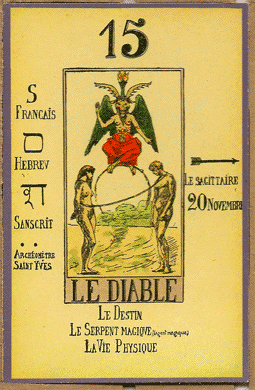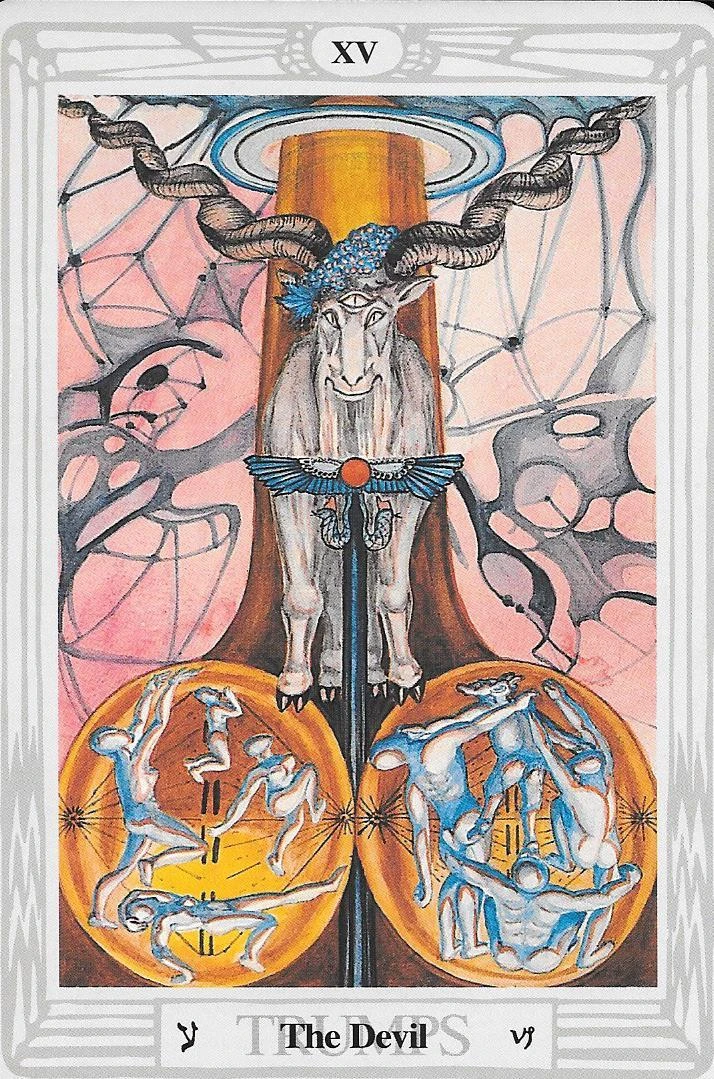Tarot Deep Dive - The Devil
- Dustin
- Nov 27, 2022
- 7 min read
Every card represents an aspect of humanity that has echoed through time. In this series we are going to dive into the history of the imagery found within the tarot, the meaning of the cards and how that meaning changed over time, and the symbols present within the images of what is arguably the most well-known tarot deck of all time - the Rider-Waite (Smith) Tarot Deck. So, grab your favorite RWS deck, a cup of tea or coffee, and join me live on Sunday mornings over on YouTube as we Deep Dive into each one of the 21 Major Arcana cards continuing now with the first of the last septenary, the card every filmmaker loves to have in their tarot reading scenes - The Devil. *A note to the reader: This topic is a long and sordid one, filled with mistranslations, misunderstandings, religious fundamentalism, and debate... lots of debate. The goal of this article is not to give a comprehensive background on this figure, but rather a brief history in order to orient ourselves, followed by our usual exploration of visual history, symbolism, and inclusion within the Tarot.

The Devil, Il Diavolo, Pan, Baphomet,
At this point in history, it goes without saying that The Devil has its origins from the Abrahamic regions. The Devil is the one who rebelled against God. This figure has come to be the personification of evil and has been historically depicted as everything from an Angel to a multi-headed dragon. The idea we have of the devil today though comes primarily from the philosophies and doctrines established during the early part of the Reformation. Most often The Devil, from Greek diabolos, meaning 'accuser or 'slanderer' is associated with Satan - a Hebrew word that originally was a common noun meaning 'accuser' or 'adversary'. This comes from Numbers 22:22 "Balaam's departure aroused the wrath of Elohim, and the Angel of Yahweh stood in the road as a satan against him." This later was the title given to the figure of Lucifer, who has his own long history.

Lucifer, which means Light Bringer, was the name of the planet Venus during Grecco-Roman times. Lucifer was often depicted as a male figure holding a torch, especially during the Renaissance and Neoclassical movements. In Ovid's Metamorphoses he describes Lucifer as the one to order the heavens. It is thought that Lucifer became associated with The Devil in a metaphor made in Isaiah 14:12 "I saw Satan fall like lightning from heaven". This is the passage used as allegory of Satan's fall from heaven. Although today we think of the devil as inherently evil, early Christians agreed that the devil had been created good and through free will chose to be evil which caused his fall from heaven. This changes around the 1400s during the Reformation where the devil became a powerful entity, a mirror of God, constantly leading people to evil, many of the modern-day tropes surrounding the devil come to us from this period in history.

The earliest visual depictions of the Devil were taken from classical pagan gods such as Pan to reinforce the idea of their wickedness. These depictions were often of devils and not THE Devil. We also see depictions lifted directly from the Old Testament with creatures such as the serpent in Genesis. Visually, the first depiction we have of The Devil as Lucifer is from a 6th century mosaic fresco in the Basilica of Sant'apollinare Nuovo. The scene depicts Christ seated between a Red and a Blue angel. In front of the red are lambs, souls going to heaven. To the right we see goats in front of the right, the souls of the damned. This blue angel is The Devil. A stark contrast to the usual image conjured up of horns and pitchforks, both symbols of which were taken from Greco-Roman gods. In the 11th century we begin to see what many of us would identify as the devil with horns today, naked clad only in a cloth to emphasize his carnal nature.

Visual Evolution


In the Tarot, The Devil is most often depicted in reference to medieval European renderings featuring grotesque monsters eating the damned in frescos of The Last Judgement, or winged Pan like figures, or a classic Hell Mouth - a early Christan and Saxon depiction inspired by Leviathan from job 41:1, a Dragon, or even Cerberus as we see later in the Middle Ages, though many scholars debate on if these actually depicted Satan or not. Interestingly, these visually look a lot like Buddhist portrayals of Naraka or the unending human suffering and the traditional Bhavachakra, a form of a Mandala, featuring Yama a Hindu of death, dharma, and the underworld. Interestingly the visual similarities and symbolism between Last Judgement scenes of the west and the aforementioned Buddhist and Hindu depictions is fascinating to explore, but that is for another time perhaps.



The image we are most familiar with in Tarot today of a Baphomet like character originates from Eliphas Levi in his book Dogmas and Rituals of High Magic, published in 1856. Here we see a very Pan like figure winged and adorned with occult symbolism including a Pentagram, Moons, Caduceus, and the latin words for dissolve and coagulate. Baphomet is generally thought to be an invented pagan or gnostic deity, first appearing in a letter dated July of 1098. Most famously the Knights Templar were accused of Worshiping Baphomet which led to the notorious event of Friday the 13th that wiped out most of the organization on the orders of The Pope and King Philip IV of France who accused the Templars denying Christ and secretly worshipping idols.
Interestingly, none of the extant Visconti decks have a surviving Devil card. Therefore, the earliest Devil card we present here is from the Rosenwald Tarot dated to the early 1500s We can see as we move forward in time how much the Baphomet depiction given to us by Levi impacted some of the most well know decks in the history of Tarot.
Evolution of Meaning
De Mellet (1781): The Devil. Typhon. Human nature defiled and enslaved.
Levi (1855): The Hebrew letter Samekh. The Devil. The Heaven of Mercury, occult science, magic, commerce, eloquence, mystery, moral force.
Mathers (1888): The Devil. Fatality for good.
Golden Dawn (1896): Lord of the Gates of Matter, Child of the Forces of Time. Devil. Material Force. Temptation, obsession, especially with the Lovers.
Waite (1910): The Devil. Violence, vehemence, fatality. What is predestined, but not for this reason evil.
Crowley (1944): This card represents creative energy in its most material form; in the Zodiac, Capricornus occupies the Zenith. It is the most exalted of the signs; it is the goat leaping with lust upon the summits of earth. The sign is ruled by Saturn, who makes for selfhood and perpetuity. In this sign, Mars is exalted, showing in its best form the fiery, immaterial energy of creation. The card represents Pan Pangenetor, the Ml-Begetter. It is the Tree of Life as seen against a background of the exquisitely tenuous, complex, and fantastic forms of madness, the divine madness of spring, already foreseen in the meditative madness of winter; for the Sun turns northwards on entering this sign. The roots of the Tree are made transparent, in order to show the innumerable leapings of the sap; before it stands the Himalayan goat, with an eye in the centre of his forehead, representing the god Pan upon the highest and most secret mountains of the earth. His creative energy is veiled in the symbol of the Wand of the Chief Adept, crowned with the winged globe and the twin serpents of Horus and Osiris
The Lovers Connection
It should be noted in the RWS, and many other decks, that there is a direct connection between The Lovers card and The Devil. Both cards have elements of choice and free will associated with them. Distinctly sharing this theme of Choice both these cards present us with a light and dark aspect of this idea. Though Waite never expressly discusses this in his writing, one only needs look at the cards to see that the figures depicted in both.
The Symbols

Inverted Pentagram The tetragrammaton inverted. Widely used by Greeks and Babalonians Pythagoreanism originated in the 6th century BC and used the pentagram as a symbol of mutual recognition, of wellbeing, and to recognize good deeds and charity. Christians once commonly used the pentagram to represent the five wounds of Jesus. The inversion of this corrupts these meanings.

Raised & Lowered Hands
A reference to the Magician - as above so below. See the Magician blog for more info.

Torch
Traditional symbol for Lucifer the bringer of light and knowledge, however in this case inverted means the opposite; ignorance and fear.

Tails
A return to carnal, primal, and uncivilized nature.

Chains Fixed to the plinth these represent attachment, compulsion, addiction, and self-serving behavior. Things you may think you are chained to, but really can free yourself from at will.

Baphomet / Devil
Baphomet is a symbol of balance in various occult and mystical traditions, the origin of which some occultists have attempted to link with the Gnostics and Templars. Some argue this is not Baphomet as the feet are those of a chicken, and therefor this represents the traditional Devil or Satan - adversary or one who stands in the way.
As always be sure to check out our live discussion on this very topic over on YouTube:
References
Barbier, L. (2021). Tarot and divination cards: A visual archive. Cernunnos, 2021.
Butler, B. Dictionary of the Tarot. New York: Schocken Books, 1986.
Chang, T. Susan. Tarot Correspondences: Ancient Secrets for Everyday Readers. Llewellyn Pulbications, 2018.
Crowley, Aleister (aleister Crowley). Book of Thoth - (Egyptian Tarot). Red Wheel/Weiser, 2017.
Dean, Liz. The Ultimate Guide to Tarot: a Beginners Guide to the Cards, Spreads, and Revealing the Mystery of the Tarot. Fair Winds Press, 2015.
Decker, Ronald; Dummett, Michael. A History of the Occult Tarot. London: Duckworth, 2019.
Fiebig, Johannes, and Evelin Burger. The Ultimate Guide to the Rider Waite Tarot. Llewellyn, 2013.
Katz, Marcus. Secrets of the Waite-Smith Tarot: the True Story of the Worlds Most Popular Tarot: with Previously Unseen Photography & Text from Waite & Smith. Llewellyn Publications, 2015.
Kelly, Henry Ansgar, Satan: A Biography, Cambridge, England: Cambridge University Press, 2006.
Place, R. M. The fool's journey: The history, art, & symbolism of the tarot. York, 2010.
Waite, A. E. Pictorial Key to the Tarot. Dover Publications Inc, 2005.
Wen, Benebell. Holistic Tarot. North Atlantic Books, 2015.















コメント